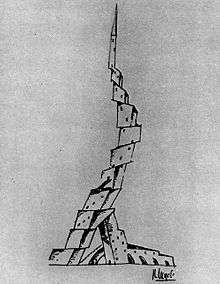Avant-garde architecture
Avant-garde architecture is architecture which is innovative and radical. There have been a variety of architects and movements whose work has been characterised in this way, especially Modernism. Other examples include Constructivism, Neoplasticism (De Stijl) and Expressionism.[1]

Concept
Avant-garde architecture has been described as progressive in terms of aesthetics. However, it is noted for covering a broad range of aesthetic and political spectrum. It is associated with the liberal left but also cited as apolitical, right-wing, and conservative in its politics and aesthetics.[2] It is also considered a stream within modernism that is anti-elitist and open to the contamination of mass culture.[3]
Critics note that avant-garde architecture contradicts the very definition of architecture because its position is contrary to its most specific characteristics.[3] Its importance is said to be exaggerated since it is always marginal to any decisive change.[4]
Architects
- Amaury Pluyaut
- Cedric Price
- Daniel Libeskind
- Frank Gehry
- Frei Otto
- Greg Lynn
- Oscar Niemeyer
- Peter Eisenman
- Rem Koolhaas
- Wolf D. Prix
- Zaha Hadid
Schools and movements
See also
References
- Heynen, Hilde (2004), "Avant Garde", Encyclopedia of Twentieth Century Architecture, Vol. 1, Taylor & Francis, pp. 97–99, ISBN 978-1579584337
- Berke, Deborah; Harris, Steven (2012). Architecture of the Everyday. New York: Princeton Architectural Press. p. 146. ISBN 1568981147.
- Baird, George (2003). The Space of Appearance. MIT Press. p. 354. ISBN 978-0-262-52343-1.
- Hays, K. Michael (1998). Oppositions Reader: Selected Essays 1973-1984. New York: Princeton Architectural Press. p. 391. ISBN 1-56898-152-X.